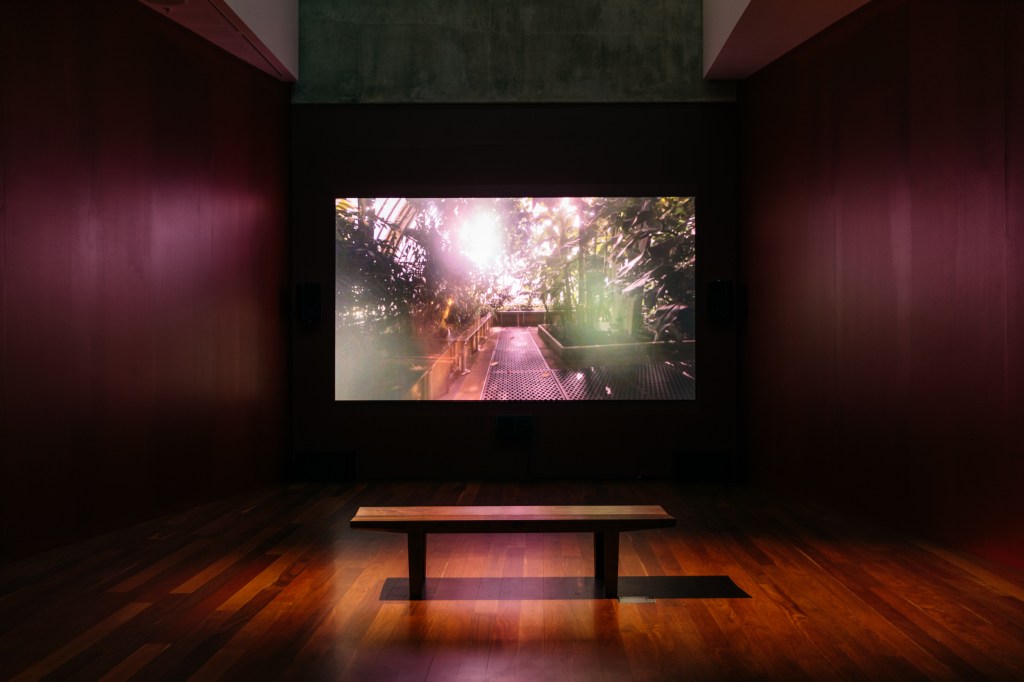You can walk into the exhibition space at any point during the continuous loop of Pilar Mata Dupont’s moving image installation, sit down on the bench that faces the trance-like film, and become slowly absorbed into its story as voices whisper and chatter from speakers around the room. ‘Take a moment to acclimatise oneself to the change in atmosphere’, an authoritative speaker encourages as images of a greenhouse float by. Settle in. Let yourself get lost. Even after sitting through several cycles of the film, it is impossible to pinpoint its ‘beginning’ or ‘ending’. Just as a pattern seems to be emerging, it becomes disconcertingly apparent that the dialogue and images are not quite matching up in the same way they did last time. ‘Hang on a minute’, says a worried voice. ‘Have we seen this before?’ I’m not sure either.
The Ague is set in the endless gardens, laboratories, and archives at Kew Gardens in London, home of the world’s most extensive botanical collection. Dupont has also drawn inspiration from Virginia Woolf’s short story, ‘Kew Gardens’, in which visitors flit past a garden bed with the same randomness as the circling insects, trailing memories and conversations. Focusing on Kew’s connection to the history of colonisation, The Ague explores the ways that preservation and classification efforts undertaken in the name of science may conceal a desire for power and control.
Three distinct sets of voices emerge from the tangle of image and sound. The most easily decipherable is a confident narrator – lecturer, tour guide, perhaps historian – who delivers facts about Kew, its people and its plants. A whisper from the side of the room cuts through the guide’s words and in fragments of story, they reveal how control of quinine supplies (made from the bark of the chinchona tree, and useful as a treatment for malaria) enabled the colonial occupation of India, with Kew playing a vital role in obtaining chinchona seeds. Most enigmatic of all are the scraps of women’s conversation woven throughout the film. At times these characters seem to be explorers on the hunt for specimens, excited by scientific discovery. But again and again they return to the subject of the oppressive heat, and their thoughts become muddled, slipping between holiday memories and existential questions.
Read: Theatre review: The Boomkak Panto, Belvoir
While the voices of the guide and the dissenting whisperer do provide some interesting facts about what is no doubt an important part of history, it is this subtler underlying conversation that compels one to keep watching, and to wonder – are these speakers from a distant time and place, or are the ramifications of colonialism more insidious, more pervasive, hitting closer to home? I came away wishing there had been a greater focus on these conversations, perhaps with a wider range of characters as in Woolf’s story.
A statement from the gallery’s curator, Gillian Brown, suggests that they are interested in exploring what it means to experience film in a gallery setting (as opposed to a cinema, or at home). It certainly seems fitting to view Dupont’s work in a context that requires the audience to abandon control of the experience: to embrace its unpredictability, its journey beyond the familiar, and those aspects that it leaves open for interpretation.
Pilar Mata Dupont: The Ague
Samstag Museum of Art, Adelaide
Showing as part of Samstag’s Spring Season until 10 December 2021
Open Tuesday to Saturday, 10am – 5pm
Free admission





